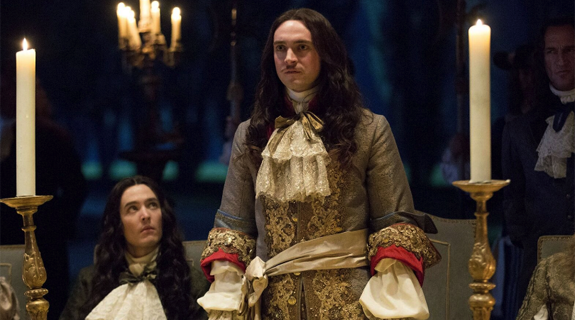At the end of first day of shooting for Versailles, Louis XIV actor George Blagden recalled a dream sequence shot in the historic French palace.
The sun dipped out from behind the clouds and orange light bounced off the mirrors and flooded the room—just as Louis XIV had designed it to do—right in time for Blagden to deliver a monologue.
As “everything came together in a beautiful, serendipitous moment,” Blagden and others on the set of Ovation’s new series were reminded just how fortunate they were to be depicting a defining moment in time in the very place where it all went down.
Blagden, along with Alexander Vlahos who plays Louis XIV’s brother Philippe, Showrunner and Executive Producer David Wolstencroft and Ovation EVP of Programming and Production Scott Woodward discussed the upcoming historical drama, set to premiere October 1, at the Television Critics Association press tour Monday.
“We were very lucky because as soon as we announced the show, the Château de Versailles was pretty much open doors for us,” Wolstencroft said.
The palace is closed to the public every Monday, so producers used that time to shoot.
Versailles, set in 1667, tells the story of King Louis XIV, a 28-year-old monarch on the cusp of greatness, known as a ruthless leader who will stop at nothing to achieve his vision of creating the most beautiful palace in Europe and seize absolute control of France and his enemies. The period genre also injects “a vibrant modernity into an era that put France at the epicenter of glamour, culture and fashion.” The series begins as Louis XIV, who became king at age 5, struggles with the death of his mother and must rise to lead on his own.
“Her death was the catalyst of this incredible journey he had to go on,” Wolstencroft said. “She was the most important figure in his formative years.”
RELATED: Design/Dissect: ‘Versailles’ Main Titles
While text books often show Louis XIV’s rule as “pretty much smooth sailing,” the series shows “this evolving, political animal” as he grows into the figure he’s known as, and helps viewers “understand the House of Cards-level politics that Louis XIV engendered,” Wolstencroft said.
That vulnerability is a trait Blagden, who didn’t want to be playing a two-dimensional character, was excited to depict on screen.
“That was kind of the key for me,” he said. “Being able to show the fragile side of this king.”
It was also important to producers that the cast be the around the true age as the characters were at the time, Wolstencroft said.
Blagden and Vlahos also played a part in picking out their characters’ costumes.
While King Louis XIV was often decked out in gold as the “Sun King,” Vlahos was conscious that the king’s brother would wear a lot of silver.
“I made the decision early on that Philippe would always be the moon to that sun,” he said.
Vlahos describes Philippe as quadraphonic: he is an open homosexual when Catholicism has deemed it wrong; he is married to a woman; he is a crossdresser; and he is a fearsome warrior.
“This person existed,” Vlahos said. “We’re not playing fictional characters here, so I hope I’m doing [him] justice.”
Overall, Wolstencroft said he hopes the series gets across the drama that led to King Louis XIV’s rise to power, and the significance of him turning his father’s hunting lodge into the Palace of Versailles —essentially the equivalent of moving Capitol Hill to Delaware because the president’s family has a vacation home there.
“We wanted it to be more about Louis taking control of his own destiny,” Wolstencroft said.
Building the palace demonstrates him wanting to control his environment as much as possible.
“Globally, it speaks to that challenge of power,” Wolstencroft said. “How do you control an unruly country? There are various ways to do it, and this is one way.”
Tags:













































__twocolumncontent.jpg)











